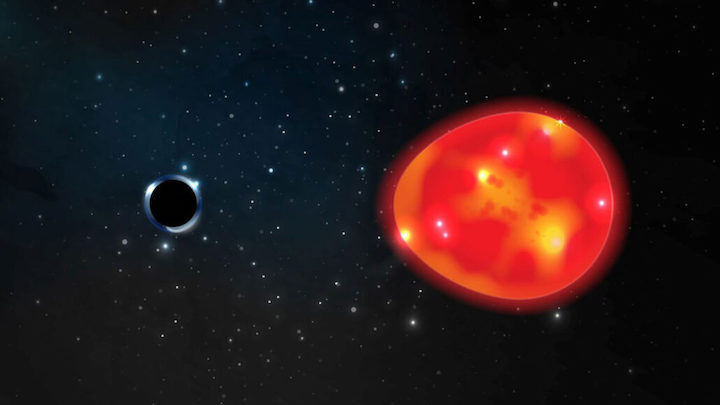6.04.2022
What scientists thought was a star orbiting a black hole turned out to be two stars instead

Astronomers originally thought that the “Unicorn” star system held a black hole and a warped red giant star, as shown in this illustration. But now researchers have found that the black hole is actually a second star.
LAUREN FANFER/OHIO STATE UNIV.
As astronomy datasets grow larger, scientists are scouring them for black holes, hoping to better understand the exotic objects. But the drive to find more black holes is leading some astronomers astray.
“You say black holes are like a needle in a haystack, but suddenly we have way more haystacks than we did before,” says astrophysicist Kareem El-Badry of the Harvard-Smithsonian Center for Astrophysics in Cambridge, Mass. “You have better chances of finding them, but you also have more opportunities to find things that look like them.”
Two more claimed black holes have turned out to be the latter: weird things that look like them. They both are actually double-star systems at never-before-seen stages in their evolutions, El-Badry and his colleagues report March 24 in Monthly Notices of the Royal Astronomical Society. The key to understanding the systems is figuring out how to interpret light coming from them, the researchers say.
In early 2021, astronomer Tharindu Jayasinghe of Ohio State University and his colleagues reported finding a star system — affectionately named the Unicorn — about 1,500 light-years from Earth that they thought held a giant red star in its senior years orbiting an invisible black hole. Some of the same researchers, including Jayasinghe, later reported a second similar system, dubbed the Giraffe, found about 12,000 light-years away.
But other researchers, including El-Badry, weren’t convinced that the systems harbored black holes. So Jayasinghe, El-Badry and others combined forces to reanalyze the data.
To verify each star system’s nature, the researchers turned to stellar spectra, the rainbows that are produced when starlight is split up into its component wavelengths. Any star’s spectrum will have lines where atoms in the stellar atmosphere have absorbed particular wavelengths of light. A slow-spinning star has very sharp lines, but a fast-spinning one has blurred and smeared lines.
“If the star spins fast enough, basically all the spectral features become almost invisible,” El-Badry says. “Normally, you detect a second star in a spectrum by looking for another set of lines,” he adds. “And that’s harder to do if a star is rapidly rotating.”
That’s why Jayasinghe and colleagues misunderstood each of these systems initially, the team found.
“The problem was that there was not just one star, but a second one that was basically hiding,” says astrophysicist Julia Bodensteiner of the European Southern Observatory in Garching, Germany, who was not involved in the new study. That second star in each system spins very fast, which makes them difficult to see in the spectra.
What’s more, the lines in the spectrum of a star orbiting something will shift back and forth, El-Badry says. If one assumes the spectrum shows just one average, slow-spinning star in an orbit — which is what appeared to be happening in these systems at first glance — that assumption then leads to the erroneous conclusion that the star is orbiting an invisible black hole.
Instead, the Unicorn and Giraffe each hold two stars, caught in a never-before-seen stage of stellar evolution, the researchers found after reanalyzing the data. Both systems contain an older red giant star with a puffy atmosphere and a “subgiant,” a star on its way to that late-life stage. The subgiants are near enough to their companion red giants that they are gravitationally stealing material from them. As these subgiants accumulate more mass, they spin faster, El-Badry says, which is what made them undetectable initially.
“Everyone was looking for really interesting black holes, but what they found is really interesting binaries,” Bodensteiner says.
These are not the only systems to trick astronomers recently. What was thought to be the nearest black hole to Earth also turned out to be pair of stars in a rarely seen stage of evolution (SN: 3/11/22).
“Of course, it’s disappointing that what we thought were black holes were actually not, but it’s part of the process,” Jayasinghe says. He and his colleagues are still looking for black holes, he says, but with a greater awareness of how pairs of interacting stars might trick them.
Quelle: ScienceNews
